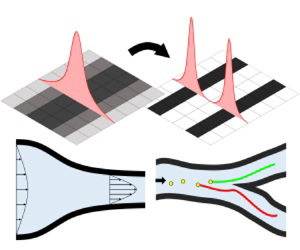Published online by Cambridge University Press: 30 April 2024

This study presents a new density filter for a pipe-shaped structure and its application to fluid topology optimization. A simple and straight pipe-shaped structure for fluid is preferred for many engineering purposes rather than the perplex manifold structure provided by the topology optimization method. To determine an optimal pipe structure for fluid, we develop a new density filter and apply it to fluid topology optimization. Hence, the original spatially varying design variables of the fluid topology optimization are modified based on the pipe density filter. Subsequently, the filter design variables, including a uniform pipe wall thickness and adjusted cross-section, are used for artificial pseudo-rigid bodies in fluid topology optimization. An additional constraint is imposed to maintain a nearly uniform pipe thickness. Several numerical examples are solved to demonstrate the validity of the present pipe density filter for fluid topology optimization problems minimizing the energy dissipation of the fluid and controlling the particles suspended in the fluid.
To send this article to your Kindle, first ensure no-reply@cambridge.org is added to your Approved Personal Document E-mail List under your Personal Document Settings on the Manage Your Content and Devices page of your Amazon account. Then enter the ‘name’ part of your Kindle email address below. Find out more about sending to your Kindle. Find out more about saving to your Kindle.
Note you can select to save to either the @free.kindle.com or @kindle.com variations. ‘@free.kindle.com’ emails are free but can only be saved to your device when it is connected to wi-fi. ‘@kindle.com’ emails can be delivered even when you are not connected to wi-fi, but note that service fees apply.
Find out more about the Kindle Personal Document Service.
To save this article to your Dropbox account, please select one or more formats and confirm that you agree to abide by our usage policies. If this is the first time you used this feature, you will be asked to authorise Cambridge Core to connect with your Dropbox account. Find out more about saving content to Dropbox.
To save this article to your Google Drive account, please select one or more formats and confirm that you agree to abide by our usage policies. If this is the first time you used this feature, you will be asked to authorise Cambridge Core to connect with your Google Drive account. Find out more about saving content to Google Drive.